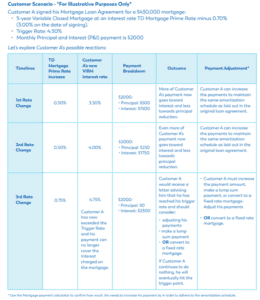Trigger Point for Canadian Variable Rate Mortgages Explained, with Example
You have likely heard – or will soon be hearing – a lot of talk about “trigger rates” and “trigger points”. More importantly, you are probably hearing “trigger point” together along with more changes in the Bank of Canada rate and you need expert guidance.
Let’s start with a few definitions:
- Variable Rate Mortgage (VRM) – prime changes, rate changes. When interest rates change, typically, your mortgage payment will stay the same.
- Adjustable Rate Mortgage (ARM) – prime changes, rate changes. Unlike variable rate, your mortgage payment will change when interest rates change.
- Trigger Rate – When interest rates increase to the point that regular principal and interest payments no longer cover the interest charged, interest is deferred, and the principal balance (total cost) can increase until it hits the trigger point.
- Trigger Point – When the outstanding principal amount (including any deferred interest) exceeds the original principal amount. The lender will notify the customer and inform them of how much the principal amount exceeds the excess amount (Trigger Point). The client then typically has 30 days to make a lumpsum payment; increase the amount of the principal and interest payment; or convert to a fixed rate term.
NOW, WHICH MORTGAGES WILL BE AFFECTED FIRST?
Quick answer, VRMs from March 2020 to March 2022.
During the month of March 2020, the prime rate dropped three times in quick succession from 3.95% to 2.45%, and variable-rate mortgages arranged while prime was 2.45% have the lowest payments. The lower the interest rate was, the lower the trigger rate, and the faster your client may hit this negative amortization.
WHAT TO DO
When this happens, customers are contacted by the lender and generally have three ways they can proceed:
- Make a lump-sum payment against the loan amount
- Convert with a new loan at a fixed-rate term
- Increase their monthly payment amount to pay off their outstanding principal balance within their remaining original amortization period
Below is a customer scenario so you can see how this could play out.

